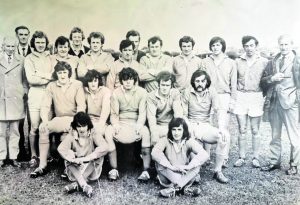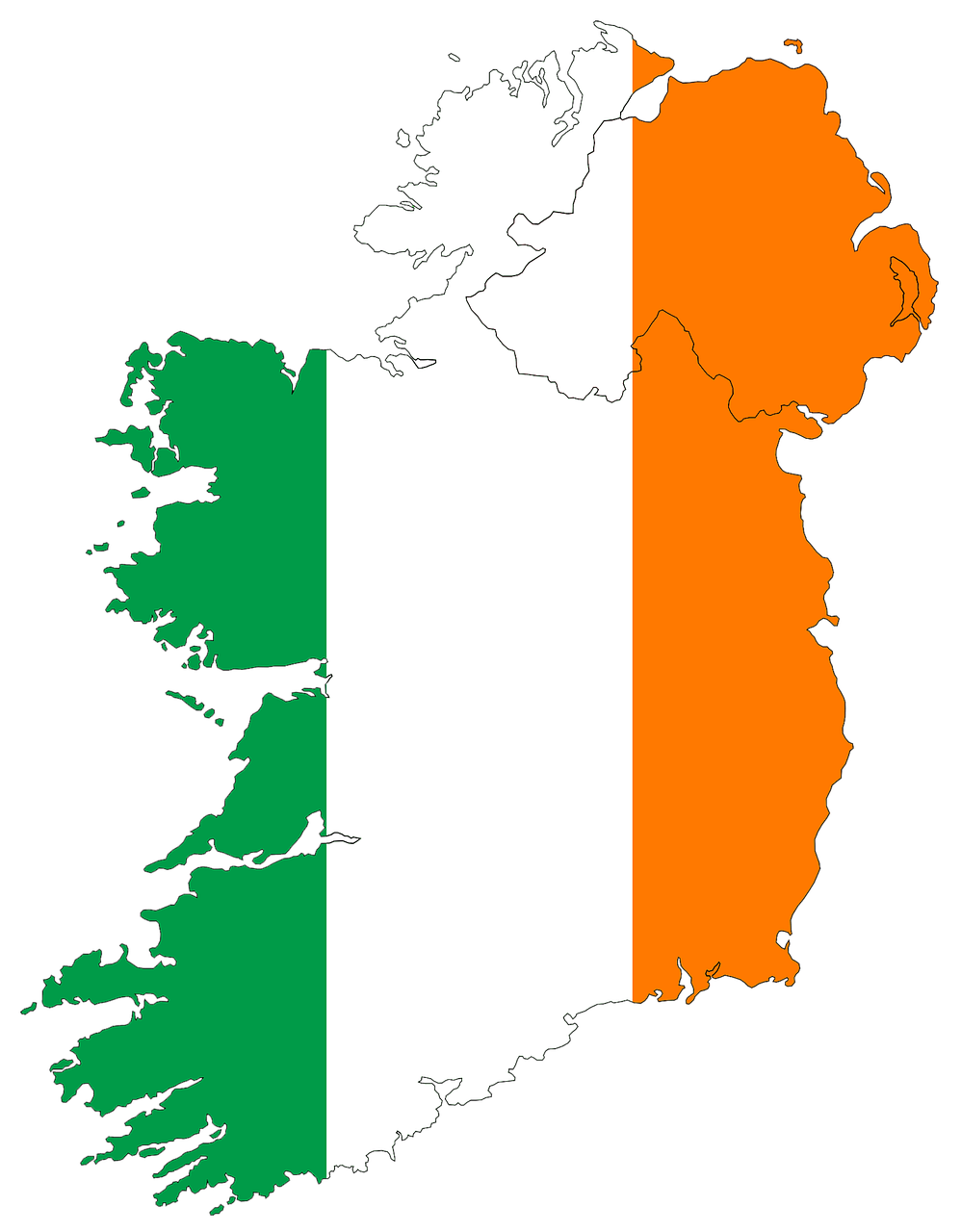
This year marks the 50th anniversary of the formation of Bruff Rugby Club. The story of Bruff Rugby since two young men of vision, Willie Conway and Nicholas Cooke in the closing days of the 1960s took the brave step of establishing a rugby club in a rural G.A.A. heartland is one of incredible and unimaginable success. It is the story of fairy tale dimensions.
Despite the remarkable popularity of rugby in Limerick city stretching back to the 1880s, the rural areas of the county traditionally provided remarkably infertile ground for growth of the game. There were a number of reasons for this. Principal among these was demographics: rugby in Ireland was generally confined to cities and larger provincial towns. Limerick, however, was among the most rural counties in Ireland. Uneven land quality meant that the county was relatively poor and Limerick possessed hardly any substantial towns apart from the city. Counties Cork and Tipperary, by contrast, had a number of large towns that allowed network of rugby clubs to develop. County Limerick was far more receptive to Gaelic games with its parish structure and its energetic efforts to expand in rural Ireland. The GAA, therefore, took root in county Limerick before any other sport had the opportunity to do so. Moreover a love for Gaelic games typically brought with it a hostility to rugby, enshrined in the GAA’s ban on ‘foreign’ games. This attitude was especially intense in rural areas.
It was little wonder, then, that rugby failed to prosper in county Limerick. One of the first members of the IRFU in the mid-1870s was a club at Rathkeale; there is no evidence that the club ever even played a match. Closer to Bruff, a club at Kilmallock emerged in the mid-1920s but disappeared in the early 1930s. A short-lived club at Holycross became branch members in 1936. Only in Newcastle-west, Limerick’s largest town outside the city, did rugby have a semi-permanent presence from the 1920s.
If history was a guide, then the circumstances were hardly propitious for the fledgling Bruff RFC. The club were accepted as members of the Munster Branch at a meeting of the Branch’s committee on 14th May 1970. On 9th April that year, three new clubs applied to the Munster Branch for ratification, Old Munchins, Ballingarry Sharks and Bruff. The Branch in their wisdom ratified the first two but deferred Bruff for further consideration but as we now know history had other plans.
That the club would survive – and prosper – to its golden jubilee is a remarkable achievement. In 1970, broader circumstances were slightly more amenable to rugby in county Limerick than in previous generations. The Irish economy opened up in the 1960s and the arrival of the Shannon Free Zone brought prosperity to Limerick. Increased car ownership brought towns like Bruff into the Limerick commuter belt and this connectivity was especially important for a new rugby club needing to travel to fulfil fixtures. Prosperity brought with it a change of attitudes. The generation that came of age in the 1960s found the GAA’s ban more than faintly ridiculous and it was a dead letter ever before its formal abolition in 1971.
But none of this would have mattered were it not for the youthful energy and dedication of the club’s founders, Willie Conway and Nicholas Cooke, both of whom came from GAA backgrounds. The early acquisition of grounds and the eventual building of a fine clubhouse gave the club a permanent focal point in the community. And an unrelenting focus on underage rugby gave the club a steady supply of players. These successes did not come about by chance but were the product of voluntary dedication and steely-eyed focus on making a success of the club.
Conway and Cooke were minor hurling team mates on the Bruff minor team of 1967. “We knew each other from hurling and two years later we decided to form the club, it was late 1969 and it was 1970 before we played our first match,” recalled Nicholas Cooke who was playing Under 20 with Shannon at the time.
The timing of setting up a club was fortuitous as the G.A.A.’s ban on foreign games was in its dying days and observed more in the breach than the observance. “At that stage people did not give a hoot about the ban,” Cooke said “Holycross had a soccer club at the time and half the country were playing with them and the G.A.A. was choosing to ignore it. There was very little talk about the ban in 1970, it was on the way out. All the country fellows that were G.A.A. minded did not mind playing rugby.”
The club’s joint founder who was club President, 2015-17 believes the time was right when Willie Conway and himself formed the club and goes on to explain why he thinks Bruff succeeded where others failed. “The major thing in those days was transport. We were two 19 year olds and all we had was one van between us. We were near enough to Limerick city to be able to get in and out of, where there were seven or eight clubs.
“There were junior and senior clubs in there and were within travelling distance and we could get all the games we wanted in the city, Ennis was a journey for us. We were centrally situated, we had Newcastlewest who we always played in the opening game of the season, we had Charleville who we would always play at Christmas, there was Abbeyfeale Clanwilliam and Galbally, we had 14 clubs within a 40 miles radius, so we were not travelling miles.”
The Knockainey native recalls Bruff’s first game which was against Charleville. “We were not sure the first day how many would turn up but we did have a team and Mike Prior turned up as bagman. We had plenty bodies for the second game against Scarriff after which we knew we were going to have a turnout every week. After two matches we had no trouble in getting out a team, we had to pick a team,” he said.
Mike Prior was one of the early stalwarts of the club and continues his association with the club to the present day.
Cooke recalls that for the first A.G.M. Colonel The O’Grady a local landowner was invited to attend. “He turned up, he was a member of Garryowen at the time and he attended most of their matches. He became our President.
Colonel O’Grady gave the fledgling club the use of a field at Kilballyowen and a lodge which was used as dressing rooms for a couple of years before a decision was taken to purchase it in 1974.
“We bought the pitch, we had it for a good few years for free and when we eventually got established, he sold it to us for a very nominal fee. That included the lodge which we had already set up before we bought it. We were now well established and were going to survive at that stage. We were making money at fundraising functions in the Golden Thatch.”
“Up until 1979, The Golden Thatch was a major source of income, anything we did by way of catering up to then, we went to the Thatch. They were odd occasions, the rest was into Gleeson’s before the clubhouse was built. It was officially built in 1979 and officially opened in November 1980.
The former President looks back at the development of the legendary underage structures in the club and how it evolved. “We had underage teams from the start but we were more successful at Under 18 than lower down the age groups as we were picking out fellows who were playing rugby in St. Munchin’s College. In the early 1980s we decided to enter teams from under 12 up and have full teams and training.
“We went from just putting teams into everything to starting young lads at 10 and eleven and letting them work their all the way up as a team to under 18. That started the underage drive with team after team.
The James Keating Under 14 Tournament was established in 1987 and is still going today and is one of the most enduring tournaments in underage rugby.
James Keating was a former Bruff player who passed away unexpectedly while out training one evening.
The focus on developing underage paid rich dividend in the late 1990s with back to back All-Ireland Under 16 All-Ireland titles in 1996-97 and 1997-98, All-Ireland Under 18 title shared with Corinthians in 1997-98 all leading to All-Ireland Under 20 success in 2000-01.
Cooke is a huge and respected figure in the club to the present day but when he and Willie Conway decided to form the club did he think it would be such a part of the local and sporting community today and a very prominent landmark on the Irish rugby landscape. “I cannot speak for Willie but for myself, it never dawned on me that we could achieve that level of success. It is a fairy tale story, it is down to the underage, they were mainly sons of fellows who were there in the early days,” he concluded.
Celebration of Half a Century of Rugby Excellence
May 21, 2020
Featured Stories, Home Slider, Vale Star





